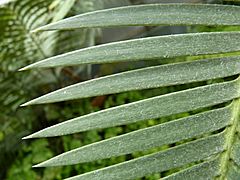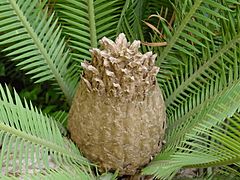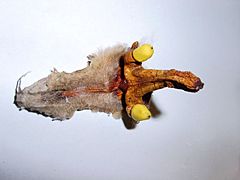Chestnut dioon facts for kids
Quick facts for kids Chestnut dioon |
|
|---|---|
 |
|
| Conservation status | |
| Scientific classification | |
| Genus: |
Dioon
|
| Species: |
edule
|
| Synonyms | |
|
|
The Dioon edule, also known as the chestnut dioon, is a special type of plant called a cycad. It grows naturally in Mexico. People sometimes call it palma de la virgen.
Cycads are super old plants. They were around even before the dinosaurs roamed the Earth! The chestnut dioon belongs to the Zamiaceae plant family. Its scientific name, "Dioon," means "two-egged." This refers to the two small structures that become seeds after the plant is pollinated.
There are two main types, or subspecies, of Dioon edule:
- Dioon edule subsp. angustifolium
- Dioon edule subsp. edule
One type grows in wetter places, and the other prefers drier areas.
Contents
What does the chestnut dioon look like?
The chestnut dioon is easy to spot because its leaves don't have sharp spines on the edges. Young plants might have spines, but they disappear as the plant gets older.
This plant has a crown of long, feathery leaves. These leaves can grow to be about 135 centimeters (about 4.5 feet) long! If you cut the plant, a sticky liquid called sap comes out.
The plant grows slowly and can handle dry weather. It has special roots that help it get water. It's often hard to tell if a plant is male or female until it grows a cone. Female plants usually take much longer to grow new cones than male plants do.
Where does the chestnut dioon live?
The chestnut dioon only grows along the eastern coast of Mexico. You can find it in the Sierra Madre Oriental mountains. It often lives in warm, dry thorn forests and oak woodlands.
These plants usually grow at high places, between 150 and 300 meters (500-1000 feet) above sea level. They like tough spots with shallow soils. The areas where they live can be very dry and often have brush fires. These fires can affect how well the plants survive and where they grow.
How does the chestnut dioon survive?
The chestnut dioon is a tough plant. Older plants can survive things like fires better than younger ones. This plant often grows in rocky, shallow soils. This is because other faster-growing plants compete for water and food.
The dioon has strong tap roots that help it stay in place and find water. It's also harder for small animals like rodents to reach the plant's seeds when they are in hard-to-reach spots.
Young dioon plants face many dangers. They have to deal with dry weather and fires. While adult plants are tough, small seeds and young plants are not as lucky. However, fires can also release good things into the soil, which helps female plants grow new cones.
Some rodents eat dioon seeds, even though most animals find cycad seeds and leaves poisonous. The caterpillars of the Eumaeus debora butterfly also eat the young leaves of the chestnut dioon.
The width of the leaves can tell us where a plant comes from. Plants with wider leaves are usually found in the south of Mexico. Plants with narrower leaves are found more in the north. This might be because the northern areas are less warm and humid.
The roots of the chestnut dioon have tiny helpers called endomycorrhizae. These are fungi that help the plant absorb more water and nutrients. The roots also have special blue-green algae that help the plant get important nutrients like nitrogen. Cycads play a big role in keeping their ecosystems healthy by helping with nitrogen.
Why is the chestnut dioon in danger?
Both types of Dioon edule are close to becoming endangered. This is mainly because of people. Their homes are being destroyed, and people collect them too much. They are wanted for gardens and for medicinal uses.
It's very hard for slow-growing plants like the chestnut dioon to recover from these problems. Experts suggest that we should protect these plants. We need to create seed banks to store their seeds. Also, there should be rules to stop people from trading cycads and to protect their homes.
Pictures
See also
 In Spanish: Dioon edule para niños
In Spanish: Dioon edule para niños





